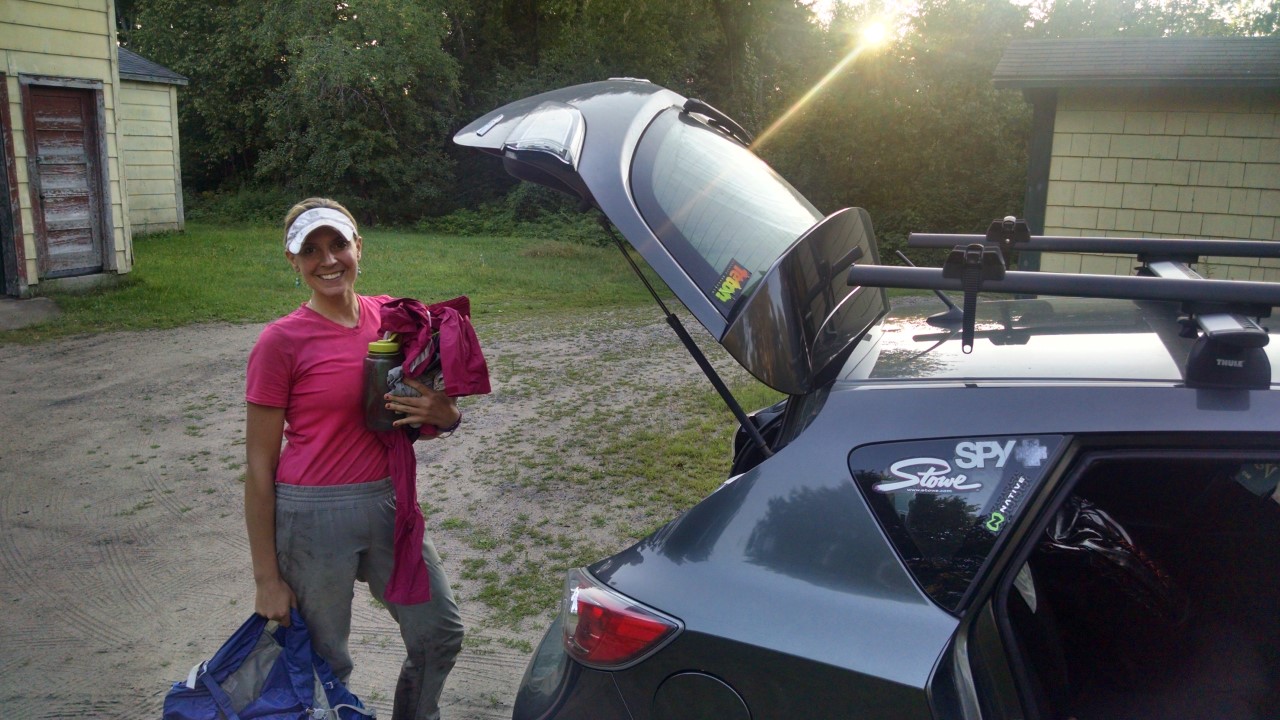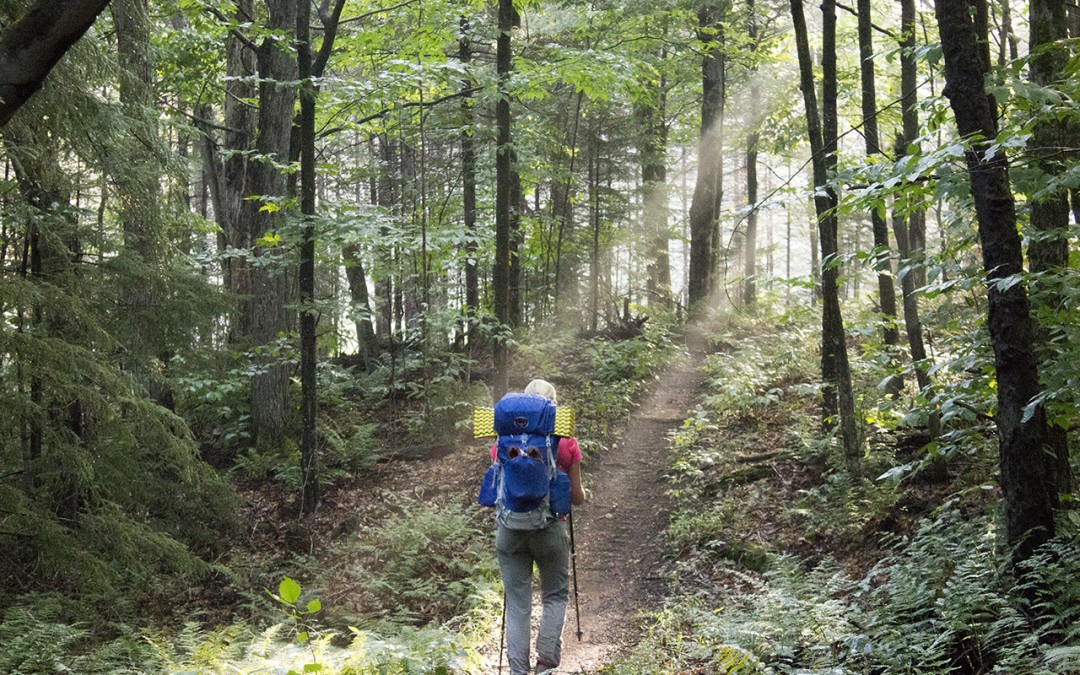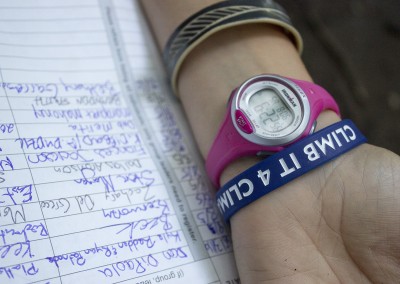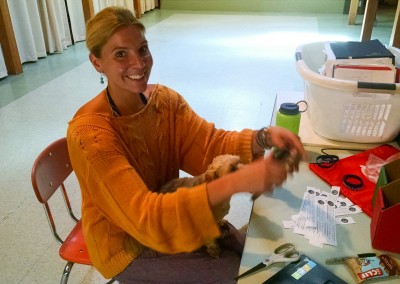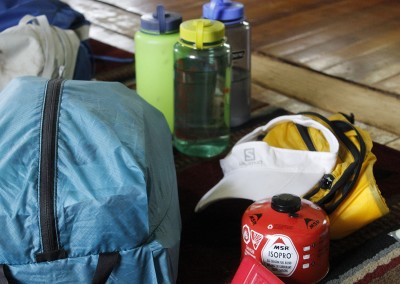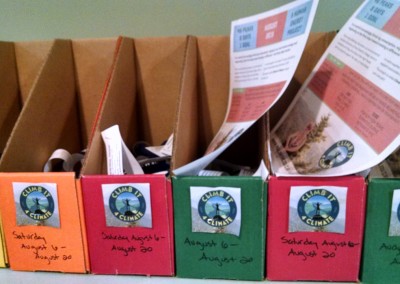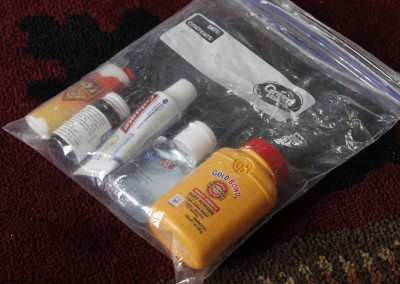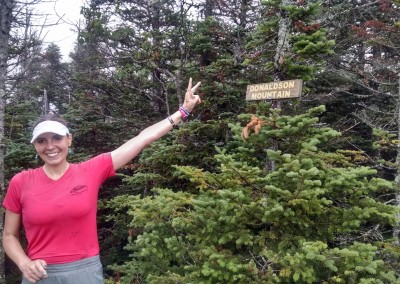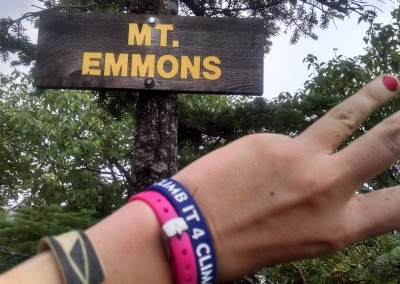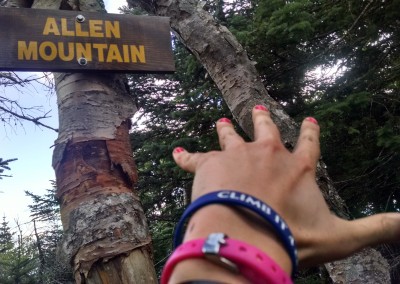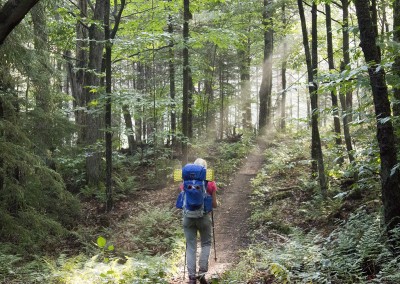Climb It 4 Climate Part 1
By Bethany Garretson
Part 1: The Count Down
Friday, August 5: Thru Hike Eve
Early morning light filtered through the trees and brightened the salmon colored walls of my office. Dewy cobwebs hung across the windows. Pinned against the walls were pictures of Adirondack summits on bluebird days. I switched on my laptop, leaned back, and stretched my arms upward. My back cracked and I bent my arms from side to side, holding each stretch for a few seconds. I was in the twenty-four hour countdown of Climb it 4 Climate and tomorrow, my alarm would sound well before the birds ruffled night from their feathers. On my whiteboard was a list of final to-dos: Bag trail mix, lay out gear, and email Paul Smith’s College community. My stomach fluttered. I took a deep breath and slowly exhaled. I knew this would be the calm part of my day—a cup of coffee, sleeping household and weather report. I brought my fingertips to the keyboard and smiled as I browsed the 10 day forecast: Mostly days in the 70s and nights in the 50s with a chance of a low 80 and thunderstorm later in the week. Not bad, I thought. Not bad.
The stairs creaked and Celia, my older sister, walked into the kitchen. I stood and placed my coffee cup in the sink. She opened a yogurt and dropped in a handful of granola and chocolate chips. We planned to start our day with a trek up Cascade and Porter. At 7am, our car was one of the first in the parking lot. Fifteen minutes on trail, we found ourselves walking along with a mother and daughter in Lake Placid for the lacrosse tournament.
“What’s the trail to Porter like? Is it muddy?” The mother asked.
“Not this year,” I said. 2016 had been dry. The trails were dusty and reminded me more of the Southwest than the Northeast. Once our exchanges about the trail conditions and weather were complete, our conversation flowed to where we lived. After I mentioned I lived in Paul Smith’s and worked for the college, Celia added, “She’s going to climb all 46 high peaks in eight days.”
The mother stopped and looked at me.
“What?” she gasped, raising her eyebrows. I rested against my trekking poles and, with a smile, delivered the cliff notes. “It’s called Climb it 4 Climate. Tomorrow, I’ll begin an unsupported thru hike of the 46 to raise money for scholarships and sustainability programs at Paul Smith’s College.” I peeled a blue rubber bracelet with the logo off my wrist and handed it to her. We’d ordered 200 bracelets with the idea to distribute them to interested hikers and direct them to the website. I found once the hike was introduced, most people followed up with one of these four questions:
- Q: What is an unsupported thru hike?
A: An effort that is unsupported means you carry all of your gear start to finish and receive no assistance from the outside world. For example, no food drops or rides to trailheads. Think of it as a point A to point B adventure. The unsupported thru hike of the Adirondack 46 high peaks is approximately 200 miles in distance and an incredible back country adventure of linking remote mountain ranges together. Each day, on average, is about 25-30 miles. Pretty much, you hike all day and set up camp at night (Adhering to DEC regulations). Currently, the unsupported thru hike record of seven days and 15 hours is held by Jan Wellford and Cory DeVavalle.
- Q: What is the difference between supported and unsupported?
A: In a supported hike, you have lots of points A and B, for drop offs and pickups, car rides, food drops, and you can recharge your MP3 player or stop at Kinney’s for extra moleskin. You can drive to and from the mountains, go home and sleep in your own bed, take a shower, wash your clothes, have a beer, etc. Because you’re carrying less gear, supported efforts tend to be at a quicker pace than unsupported.
- Q: What inspired me to attempt an unsupported thru hike?
A: I heard about the unsupported thru hike in 2009, the year I graduated from Paul Smith’s College and began hiking the High Peaks. At that time in my life, I was struggling to make sense of the world and my place in it. In the mountains, I found a voice, peace, and direction. My feet came alive on trail and hiking and climbing were a natural fit. I yearned to be on trail and explore the Adirondacks. The mountains were teaching me life skills I didn’t learn in textbooks. After a trek up Mount Marcy, I was jogging out South Meadows road and I came upon a bird watcher from Montana. We talked a bit about Yellowstone and Glacier and she gave me a newspaper article about a man who hiked all 46 in four days (supported). The article was fascinating, inspiring, and after I finished reading it, I began planning my route. I’ll never forget that day—it was like being handed a book that forever changes your life and perspective.
- Q: How did I train?
A: Physically: During the months of June and July, I aimed for 50 miles a week on trail. The 50 miles were a combination of walking, hiking, and trail running. I did a lot of low impact, high mile days on the VIC trails. I usually got into the High Peaks at least twice a week. Even if it was just an evening jaunt up Cascade and Porter, it worked my legs and I was able to test new gear. Every other week, I squeezed in a high mile and heavy pack overnight—to get accustomed to my full pack and camping gear. By the time I was two weeks out from August 6, I was ready and itching to go.
Mentally: The mental components of a hike are unpredictable. I talked with Cory and Jan over the summer about their successful thru hike and what had been the most challenging components. The truth is, there’s no way to equate one’s experience with another’s. And I knew that. However, they both gave me golden nuggets of advice:
Cory: “This hike will be a culmination of all the hikes you’ve ever done. On trail, you will pull from the past to push forward.” (This was incredibly true and kept me moving at some of the hardest moments—knowing I’d done and completed more challenging hikes in the past).
Jan: “You can do it. It’s just a matter of doing it” (It may be a simple line, but coming from one of the ADK legends and guru’s of hiking—it meant a lot. Also, Jan is no bs-er—he’s a humble and honest guy).
The mother and daughter wished me luck as we ascended past them. I tapped my trekking poles against a rock and thanked them. Along the hike, Celia was a great spokesperson—pitching the climb and the mission. I was a bit reserved and maybe it was just the, “Oh, s**t,” factor of knowing 24 hours from now, I’d be on trail heading up Seward Mountain. In addition to my pre-hike nerves, I knew I hadn’t accomplished anything yet. I was just proposing to do something. I knew how incredibly hard it would be and it would only take one good ankle role to be out for the count. What if my stove didn’t work? What if a bear broke into my canister? (What if, what if, what if…). To top off my jitters, the week had been packed with radio, TV, and newspaper interviews. I’d had a Skype session with CNN and they’d asked if I could document the journey with a video journal. Jack LaDuke from Mountain Lake PBS called to confirm what time I’d be at the Seward trail head tomorrow morning. The press was a great opportunity to get the message out there. And at the same time, I felt overwhelmed, knowing it was a great story if I accomplished it. More importantly, the heart of the story wasn’t about a woman trying to break the unsupported thru hike record. It was about building community resilience in a time of a changing climate, and raising funds for Paul Smith’s College. With the Olympics starting on the same day as my hike, I made the analogy that the hike was like going to the Olympics. I’d qualified. However, everything had to line up just right to get that Gold medal.
When we got back to the house, I went through my gear—breaking it into categories and checklists. Jossalynn, my seven-year-old niece helped bag eight days’ worth of trail mix. In ziplock bags we sealed combinations of peanuts, raisins, packets of peanut butter, dates, prunes, chocolate covered pretzels, Nori’s chunks of energy, chocolate espresso beans, and Cliff bars. Yes, I love chocolate. Each day on trail, my goal was to consume 3000 calories. The majority of those calories would come from two mountain meals and the rest from my bags of trail mix. Jossy was curious about the variety of food before her. After a round of sampling, she declared the chocolate covered pretzels to be her favorite and with a scrunched nose, handed me a half eaten date, which obviously did not get her stamp of approval. I stood and surveyed the room. All spread before me, it looked like this:
Break down of my gear:
*Clothing: 3 pairs of socks, 2 pair of shoes (1 hiking boot and 1 trail runner), 1 poly top, 1 poly bottom, 1 long sleeve quarter zip, 1 rain jacket, 1 beanie, 1 pair of gloves, 1 visor, 1 pair of underwear, 1 sports bra, 1 short sleeve quick wick top, 1 pair of quick wick pants and 1 stuff sack.
*Food: 1 bear canister, 16 mountain meals, multiple baggies high fat/protein/carbohydrate trail mix, 1 pocket rocket and 8 oz fuel canister.
*Water: 2 Nalgenes, 1 bottle of iodine tablets, 1 bottle electrolyte tablets, and 3 baggies of electrolyte mix.
*Sleeping gear: 1 fleece liner, 1 emergency blanket, 1 mosquito net, 1 tarp and stake set.
*Pack: 1 44 L Osprey pack and pack cover, 1 lightweight day pack
*Survival gear: 2 lighters, 1 map, 1 compass, 1 bottle of hand wash soap, 1 whistle, 1 headlamp and extra batteries, 1 Spot pager and extra batteries.
*Extras: 1 MP3 player, 1 journal and pen, 1 Outside magazine, 1 set of trekking poles, and 1 medical kit (consisting of: moleskin, athletic tape, and Ibuprofen).
The checks on my to-do list were complete. I felt like a kid on Christmas Eve—full of flutters and nerves and beautiful excitement. The house was quiet. Barefoot, I walked to our fire pit and called my mother.
“Are you ready?” she asked.
“Yep,” I nodded and dug my feet into the grass.
“I have a good feeling about this,” she said.
“Me too.”
*
Day 1: Saturday, August 6
Start: 6:23 am from Corey’s Parking Lot
Mountains: Seward, Donaldson, Emmons, Seymour
Miles: 29
Camp: Santanoni lean-to area
Sleep proved to be fitful the eve of the thru hike. Thunderstorms rolled through around 3am and broke the humidity. I rose at 4am and silenced the alarm I’d set for 4:15. Blessed with the gift of ample energy in the morning, I jumped out of bed, grabbed a pile of clothes and tip toed down stairs. My pack and trekking poles leaned against the living room wall. I turned on the burner to boil water for my oatmeal. After a few more hits on the snooze button, my husband Andy joined me in the living area to pack gear. Eyes swollen with sleep, he grasped his cup of espresso and stared out into the dark morning. My wrist was adorned with a watch and a climbit4climate bracelet. Around my neck, I fastened a crescent moon necklace Andy had made out of burl wood. The bracelet and necklace were my two power items—reminders of the bigger picture when times got tough on trail. Andy and I loaded the car—a pack each and our small terrier/dachshund mix, Tahawus. I cradled him on my lap as my mind double- and triple-checked to make sure I had everything.
“Alright?” Andy asked, his hand on the shifter.
“Alright,” I said. I pulled my seat belt over my shoulder and fastened—this was the beginning, the official launch pad. The road was wet from the early morning thunderstorm. Fog lifted off the ponds and lakes. Streaks of morning light poked through the hardwoods that lined Corey’s road. My knee bounced up and down—in synch with the loud music. At the trailhead, Jack LaDuke rested against his car—the rear popped open and camera gear ready to go. I traded my sandals for hiking boots, pulled off my fleece and strapped into my pack. I adjusted the hip belt and rocked it side to side. The 44 L pack felt light and comfortable—weighing in at 30 pounds. Before teaching at Paul Smith’s College, I’d been a wilderness therapy instructor for four years and led expeditions in the same back country I’d be covering today. Then, it was with a 50- to 60-pound pack bulging at the seams. As a wilderness instructor, not only did we have packs on our backs, we also carried smaller day packs on our front. In comparison, today, I felt nimble in my Osprey. Jack snapped a photo as I signed in at 6:23 am and we waved goodbye. The trail to Seward was idyllic with soft beams of light filtering through the canopy. At the split for Seward, Andy and I walked off trail, found a flat spot and I dropped my full pack. I unfurled my ground pad and emptied my gear. I opened my bear canister and pulled out a ziplock of trail mix. I topped off my two water bottles, dropped them with iodine and switched my hiking boots for trail runners. Now only carrying my essential layers, gear, and food—I set off for my first high peak.
Seward welcomed me to trail with cobwebs and rain laden boughs. Within a quarter mile, I was damp and muddy. There might have been a drought going on in the Adirondacks, but you’d never know it sloshing through the mud pits of Seward. Branches pulled at me on the narrow trail. My shoe caught a loose root and I stumbled forward, just able to catch myself before a face plant.
“Slow down, Bethany,” I scolded, through clenched teeth. This was an endurance race, not a sprint. I had scores of pent up energy bursting forth. I was out of sync and thinking too far ahead—trying to guess when I’d be setting up my sleeping gear.
“One mountain at a time, one step at a time,” I mumbled my mantra and it helped me refocus.
I got to the summit of Seward and strode past. “I’ll take a photo on the way back,” I said, still searching for a flow. I was soaked, but it was humid and I was comfortable if I kept moving. Plus, I liked being on the cooler side and I had dry layers in my pack if I ran into a survival situation.
On Donaldson’s summit, there was a woman looking off to the east. “Would you like me to take your photo?” she asked.
“Sure,” I said and passed her my phone. I held up two fingers to represent the second summit of the day and she snapped a photo.
“Are you that girl hiking all 46?” she asked.
“Yeah!”
“Awesome! I read about you and I’m going to post my climbs.” She stepped forward and gave me a high five.
“Thanks! I really appreciate that.” I wished her happy trails and jumped off the summit rock with new found energy. In the Sewards, hikers spread the word about Climb it 4 Climate. Many people clapped, cheered, and shook my hand as I passed by. It was surreal—and I felt like a strange, sweaty celebrity in the backcountry. Thanks to a generous donor, anyone who climbed a high peak between August 6 and August 20 and posted it to our facebook page, brought in 10 dollars to the cause. While I was on the trail attempting the unsupported record, any PSC community member who climbed a high peak brought in 100 dollars.
For me, this hike had two goals:
- Demonstrate the power of community-based change.
- Acknowledge our changing world and raise money for programs that enable our students to build more sustainable and resilient communities.
The Seward Range was mystical. A low fog moved through the shrubby high mountain forest and gave the morning an eerie Sleepy Hollow vibe. On the summit of Emmons, I paused long enough to take a photo and down a few swigs of punch-flavored electrolytes. Then it was back over the range and down Seward. My spirits lifted when flat terrain greeted my feet and I could see my support crew (Andy and Tahawus) sitting by the river.
“There’s a surprise for you on Seymour,” Andy said. As I packed my gear, I thought about who I might meet on trail. No doubt, the surprise was a hiker I knew. At the base of the Seymour trail I set down my full pack. The transition from a full pack to day pack was smooth. I knew every piece of gear, and systems were falling into place. Spend enough time in the backcountry and you’ll find it’s all about systems: gear systems, weather systems, and ecosystems.
Headed up Seymour, it was a bit past noon when my surprise spotted me.
“Bethany!” a familiar voice boomed. I looked up and smiled—before me were two Adirondack legends: Janet Stein and Pin Pin. Janet and I met during wilderness therapy when I was an aspiring 46er and she a full blooded badass with a hiking resume that looked a bit like this: Winter 46, 46er multiple times over, climbed Mount Kilimanjaro, and completed the Northeast 111. Needless to say, I was in awe of Janet. I respect her passion for the mountains and the motto by which she has crafted her life. We didn’t see each other as much as we’d like, but when we did we made it count. Whether it was completing a 29-mile circuit around Cranberry Lake or pursuing Grace’s slide on a clear fall day. Pin Pin’s hiking resume was equally impressive with 100 completed rounds of the 46. Janet swung me back and forth in a bear style hug.
“You go girl!” she said. The three of us chatted for a few minutes before we parted ways and I continued upward. On the summit of Seymour, I thought about Janet and Pin Pin. I thought about the places our feet and inner determination can take us. How beautiful it is to climb a mountain and walk away with a different view no matter how many times you climb it.
The rest of the day consisted of full pack miles along forgotten trails. From the base of Seymour to Duck Hole, there were a lot of fallen logs to step over. In 2011, the power of Hurricane Irene had washed out the dam. Every year since, the grasses and forests rose up and reclaimed land that had once been theirs before man intervened. On the river’s bank, I set up the stove and fixed a bowl of oats. I leaned back and watched a bank of clouds pass over the sun. I closed my eyes. The frantic pace of yesterday and the morning had dissipated with each mile and layer of sweat. I’d found my endurance pace and it told me, “Lay back, touch sky and soak in this experience.”
